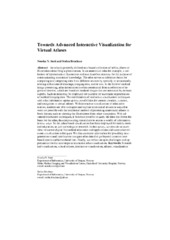| dc.contributor.author | Smit, Noeska Natasja | |
| dc.contributor.author | Bruckner, Stefan | |
| dc.contributor.editor | Rea, Paul M. | |
| dc.date.accessioned | 2020-04-16T07:49:14Z | |
| dc.date.available | 2020-04-16T07:49:14Z | |
| dc.date.issued | 2019 | |
| dc.Published | Smit NN, Bruckner S: Towards Advanced Interactive Visualization for Virtual Atlases. In: PM Rea. Biomedical Visualisation, 2019. Springer p. 85-96 | eng |
| dc.identifier.isbn | 978-3-030-19384-3 | en_US |
| dc.identifier.issn | 0065-2598 | en_US |
| dc.identifier.issn | 2214-8019 | en_US |
| dc.identifier.uri | https://hdl.handle.net/1956/21886 | |
| dc.description.abstract | An atlas is generally defined as a bound collection of tables, charts or illustrations describing a phenomenon. In an anatomical atlas for example, a collection of representative illustrations and text describes anatomy for the purpose of communicating anatomical knowledge. The atlas serves as reference frame for comparing and integrating data from different sources by spatially or semantically relating collections of drawings, imaging data, and/or text. In the field of medical image processing, atlas information is often constructed from a collection of regions of interest, which are based on medical images that are annotated by domain experts. Such an atlas may be employed, for example, for automatic segmentation of medical imaging data. The combination of interactive visualization techniques with atlas information opens up new possibilities for content creation, curation, and navigation in virtual atlases. With interactive visualization of atlas information, students are able to inspect and explore anatomical atlases in ways that were not possible with the traditional method of presenting anatomical atlases in book format, such as viewing the illustrations from other viewpoints. With advanced interaction techniques, it becomes possible to query the data that forms the basis for the atlas, thus empowering researchers to access a wealth of information in new ways. So far, atlas-based visualization has been employed mainly for medical education, as well as biological research. In this survey, we provide an overview of current digital biomedical atlas tasks and applications and summarize relevant visualization techniques. We discuss recent approaches for providing next-generation visual interfaces to navigate atlas data that go beyond common text-based search and hierarchical lists. Finally, we reflect on open challenges and opportunities for the next steps in interactive atlas visualization. | en_US |
| dc.language.iso | eng | eng |
| dc.publisher | Springer | en_US |
| dc.relation.ispartof | Biomedical Visualisation | |
| dc.relation.ispartofseries | Advances in Experimental Medicine and Biology | eng |
| dc.title | Towards Advanced Interactive Visualization for Virtual Atlases | en_US |
| dc.type | Chapter | |
| dc.type | Peer reviewed | |
| dc.date.updated | 2020-01-24T14:09:53Z | |
| dc.description.version | acceptedVersion | en_US |
| dc.rights.holder | Copyright Springer Nature Switzerland AG 2019 | en_US |
| dc.identifier.doi | https://doi.org/10.1007/978-3-030-19385-0_6 | |
| dc.identifier.cristin | 1742621 | |
| dc.identifier.citation | In: PM Rea. Biomedical Visualisation, 2019. Springer p. 85-96 | |
